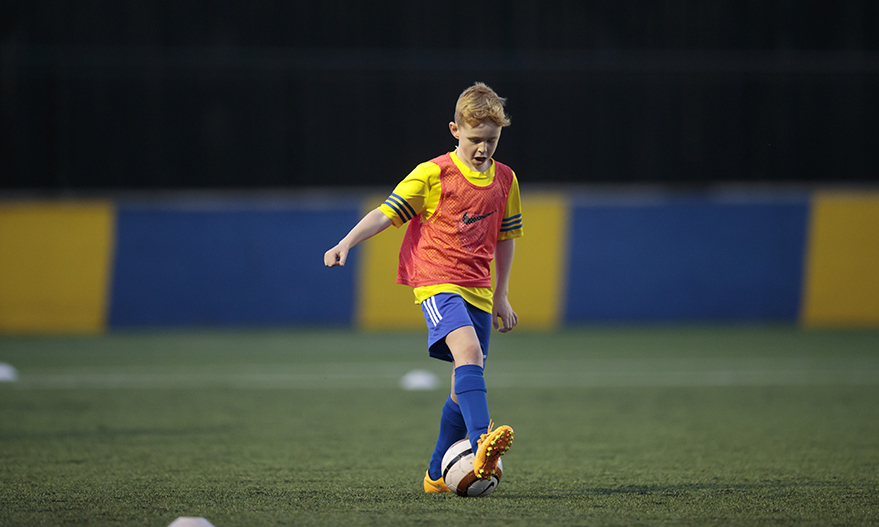Guides

How to help 5-11 year olds stay on the ball and master it
- The Boot Room
- 07 August 2020
During the Foundation Phase, we need to encourage our teams to develop confidence on the ball. This means that instead of focusing on passing early, our coaching should concentrate on helping our players develop a real connection with the ball.
Master the Ball
Children in the Foundation Phase want to improve and develop their skills – they’re ready to learn. Mastering the ball includes building the capability to manipulate and manoeuvre the ball in any direction, at varying speeds and by using any part of the foot or body. These skills can then be used when dribbling, travelling with the ball, turning, receiving, shielding, or screening the ball during any activity or game.
The practice required to master the ball can’t be skimmed over, rushed or – at worse – overlooked. Developing these fundamental skills will form the basis for all development that follows and the Foundation Phase is a perfect time to start, as young players are ready to explore and experiment. Coaches should encourage this and ensure that players get lots of ball contact (combined with appropriate levels of decision-making), by providing a wide range of small-number activities and games.
There are many methods to use to begin practising ball mastery: from isolated ball-familiarity exercises that promote touch, feel and manipulation (but require very little decision-making capability), to small-number activities, games and formats that will bring returns in all of the four corners (technical, physical, psychological and social). As a coach, the method you use should be determined by the needs of the group and within that, where possible, the needs of each individual player.
Stay on the Ball
It’s difficult to say which part comes first - master the ball or stay on the ball - because in promoting one you’re almost certainly working on the other. However, once players grow in confidence because of their improving ability on the ball (i.e. improving mastery), we need to encourage them to stay on the ball for longer. This doesn’t mean ‘hog the ball’ or dribble until possession is lost: staying on the ball is about the player knowing that they are able to keep the ball for longer, regardless of the pressure from the opposition or from the lack of space available.
Once players develop confidence in their own ability, time can be spent on thinking about how they might attack and score for themselves – or help others to do the same. For our under 5-8 players this must be established in such a way that their technique is still good even though there’s more pressure. This could take years of practice, so ensure you give players lots of variety and opportunities to begin to develop these important, fundamental techniques.
Better technical skills means that players can look for more attacking, threatening and creative options, rather than the easy or predictable ones. More time on the ball means that the game may change whilst a player still has the ball: supporting positions might change into more attacking ones, the player on the ball may suddenly turn or dribble out of pressure and the whole pitch might open up before them.
These situations never occur if the player is told to always pass the ball early and to the easiest option.
This is probably the hardest part for adults to deal with, let alone actively encourage and promote. It’s the hardest and most frustrating because there will be lots of mistakes whilst these skills and abilities are developed. It’s vital that coaches adopt a patient and consistent approach, so players feel supported when developing this aspect of their game.
It will be well worth the wait: remember that development is a long-term process and by staying on the ball, players will develop their dribbling skills, their turns, twists and their spins away from pressure.
The young players will have to become good at ‘hiding’ the ball away from opponents, and brilliant at not only knowing when to release the ball but who to release it to. This capability will stay with them for the rest of their playing time and the England DNA promotes this aspect of development right through the phases.
The part you play as a Foundation Phase coach is important, because you start the whole process off and, if done with real passion and enthusiasm, it will be your legacy and your massive contribution to the development of our young players.
Reasons for players to stay on the ball include the following:
- They have no positive or threatening passing options and they are prepared to stay on the ball and see if one appears.
- There’s space in front of, to the side or behind them – and they can change the situation in the game to a more positive, attacking one by travelling with the ball.
- They have recognised that the situation is 1v1 and they are going to dribble with the ball.
- They’re under pressure, passing options are compromised and they are willing to relieve the pressure and change the situation by screening, shielding or turning with the ball.
- All of their options are sideways and backwards and staying on the ball may allow the situation to change and present a forward, positive, more attacking option.

If this is your current situation in the game, can you change it by staying on the ball?
To develop ball mastery and the ability and confidence to stay on the ball is really important for players at the youngest end of the Foundation Phase, so please make sure this development is prioritised. Some of your players will be at the stage where managing the ball is all they can cope with. Give them the time they need and provide them with enjoyable ways to practice mastering these skills.
To learn more about Foundation Phase DNA, click here.

























